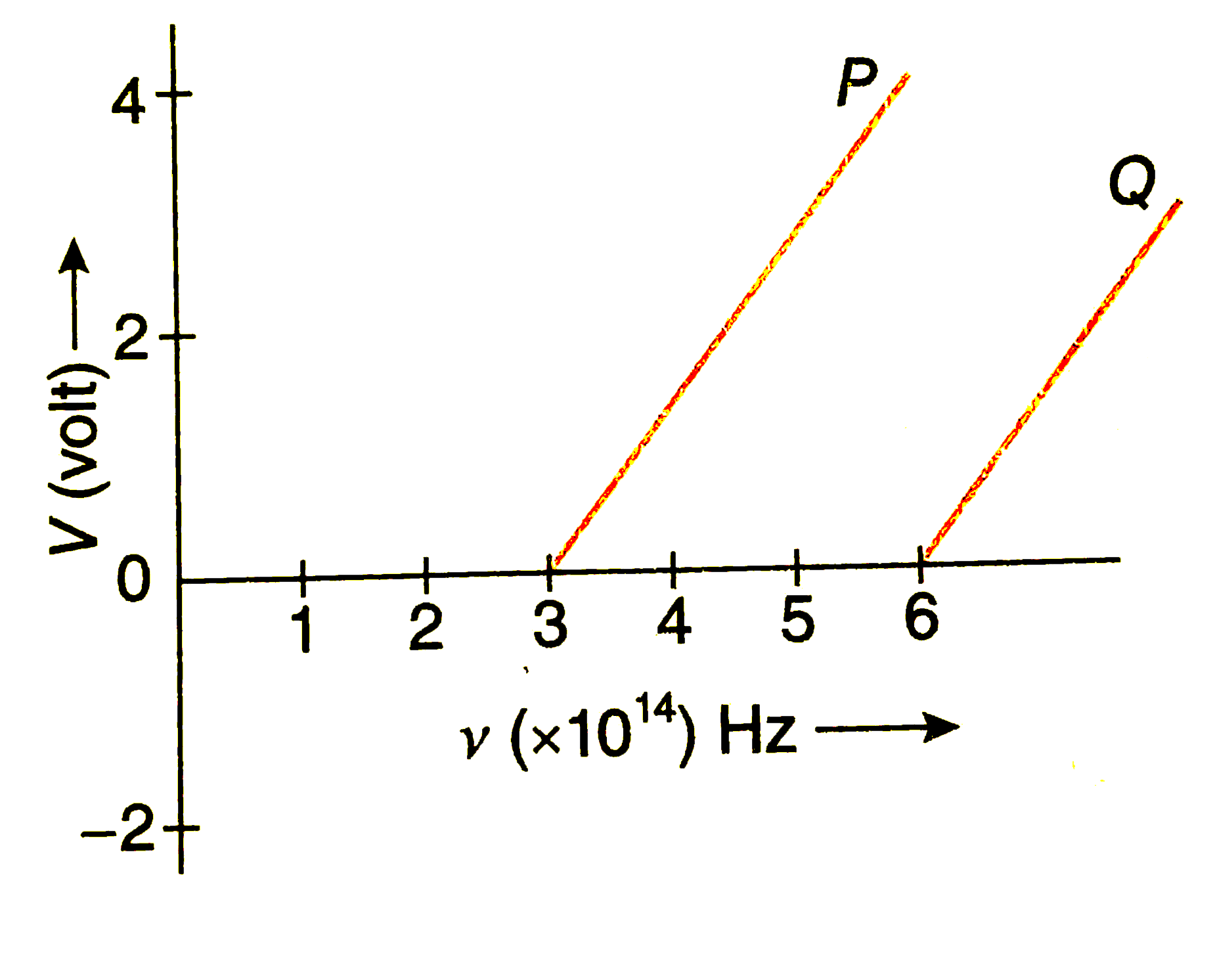In the study of a photoelectric effect the graph between the stopping potential V and frequecy v of the incident radiation on two different metals P and Q shown in
(b) Determine the work function of the metal which has greater value.

Work function of metal Q,
WQ=hvQ=6.6×10−34×6×1014
=39.6×10−20J=2.47eV
Topper's Solved these Questions
- QUANTUM THEORYBOOK - CHHAYA PUBLICATIONCHAPTER - QUANTUM THEORYEXERCISE - Examination Archive with solutions
39 Videos
- OPTICAL INSTRUMENTSBOOK - CHHAYA PUBLICATIONCHAPTER - OPTICAL INSTRUMENTSEXERCISE - CBSE SCANNER
8 Videos
- QUESTION PAPER OF NEET 2017BOOK - CHHAYA PUBLICATIONCHAPTER - QUESTION PAPER OF NEET 2017EXERCISE - QUESTION PAPERS OF (NEET) (2017)
39 Videos
Similar Questions
What will be the kinetic energy of emitted photoelectrons if light of threshold frequency falls on a metal?
View SolutionDefine the magnifying power of a compound microscope when the final image is formed at infinity . Why must both the objective and the eyepiece of a compound microscope has short focal lengths ? Explain.
View SolutionA molecule of a substance has permanent dipole moment p. A mole of this substance is polarised by applying a strong electrostatic field E. The direction of the field is suddenly changed by an angle of 60∘. If N is the Avogadro's number the amount of work done by the field is
View SolutionThe stopping potential as a function of the frequency of the incident radiation is plotted for two different photoelectric surfaces A and B . The graphs show that work function of A is

View SolutionIn the study of a photoelectric effect the graph between the stopping potential V and frequency v of the incident radiation on two different metals P and Q is shown in fig. (i) which one of two metals have higher threshold frequency (ii) Determine the work function of the metal which has greater value (iii) Find the maximum kinetic energy of electron emitted by light of frequency 8xx10^(14) Hz for this metal.
View SolutionIn a photoelectric effect experiment, the graph between the stopping potential (V) and frequency (v) of the incident radiations on two different metal plates P and Q are shown in plates, P and Q has greater value of work function ? (ii) What does the slope of the lines depict?
View SolutionThe graph between the stopping potential V_(0) and frequency v for two different metal plates P and Q are shown in the figure. Which of the metals has greater threshold wavelength and work function.
View SolutionIn photoelectric effect the work function of a metal is 3.5 eV. The emitted electrons can be stopped by applying a potential of –1.2 V. Then
View SolutionIn a photoelectric effect experiment , photons of energy 5 eV are incident on metal surface . They liberate electrons which are just stopped by an electrode at a potential of 3.5 V with respect to metal . The work function of the metal surface in eV is :
View SolutionWhich of the following is the graph between the frequency (v) of the incident radiations and the stopping potential ?
View SolutionThe stopping potential as a function of frequency of incident radiation is plotted for two different photoelectric surfaces A and B . The graphs as shown in figure shows that , the work function of A is
View SolutionIn photoelectric effect, the work function of a metal is 3.7 eV. The emitted electron can be stopped by applying a potential of 1.8 V. Then
View SolutionEjection of the photoelectron from metal in the photoelectric effect experiment can be stopped by applying 0.5 V when the radiation of 250 nm is used. The work function of the metal is
View SolutionDefine photoelectric effect. Draw a graph to show the variation of stopping potential with frequency of incident radiation on a metal plate.
View SolutionIn the study of a photoelectric effect the graph between the stopping potential V and frequency nu of the incident radiation on two different metals P and Q is shown in fig. (i) which one of two metals have higher threshold frequency (ii) Determine the work function of the metal which has greater value (iii) Find the maximum kinetic energy of electron emitted by light of frequency 8xx10^(14) Hz for this metal.
View SolutionThe stopping potential as a function of the frequency of the incident radiation is plotted for two different photoelectric surfaces A and B . The graphs show that work function of A is

View Solution

